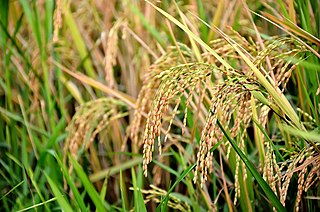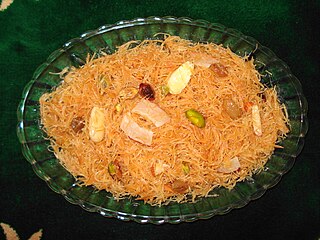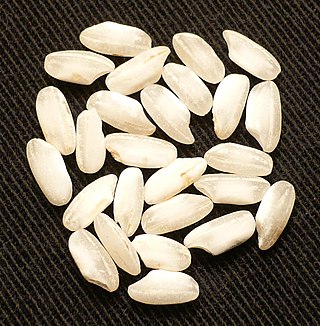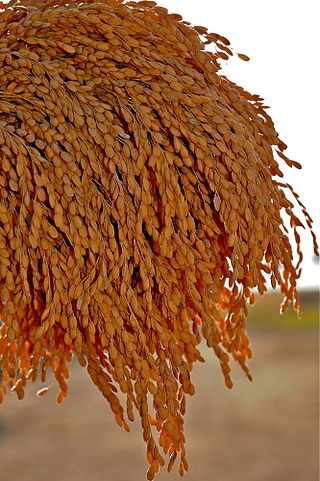
A cereal is a grass cultivated for its edible grain. Cereals are the world's largest crops, and are therefore staple foods. They include rice, wheat, rye, oats, barley, millet, and maize. Edible grains from other plant families, such as buckwheat and quinoa are pseudocereals. Most cereals are annuals, producing one crop from each planting, though rice is sometimes grown as a perennial. Winter varieties are hardy enough to be planted in the autumn, becoming dormant in the winter, and harvested in spring or early summer; spring varieties are planted in spring and harvested in late summer. The term cereal is derived from the name of the Roman goddess of grain crops and fertility, Ceres.

Rice is a cereal grain and in its domesticated form is the staple food of over half of the world's population, particularly in Asia and Africa. Rice is the seed of the grass species Oryza sativa —or, much less commonly, O. glaberrima. Asian rice was domesticated in China some 13,500 to 8,200 years ago; African rice was domesticated in Africa about 3,000 years ago. Rice has become commonplace in many cultures worldwide; in 2021, 787 million tons were produced, placing it fourth after sugarcane, maize, and wheat. Only some 8% of rice is traded internationally. China, India, and Indonesia are the largest consumers of rice. A substantial amount of the rice produced in developing nations is lost after harvest through factors such as poor transport and storage. Rice yields can be reduced by pests including insects, rodents, and birds, as well as by weeds, and by diseases such as rice blast. Traditional rice polycultures such as rice-duck farming, and modern integrated pest management seek to control damage from pests in a sustainable way.

Porridge is a food made by heating or boiling ground, crushed or chopped starchy plants, typically grain, in milk or water. It is often cooked or served with added flavourings such as sugar, honey, fruit, or syrup to make a sweet cereal, or it can be mixed with spices, meat, or vegetables to make a savoury dish. It is usually served hot in a bowl, depending on its consistency. Oat porridge, or oatmeal, is one of the most common types of porridge. Gruel is a thinner version of porridge and congee is a savoury variation of porridge of Asian origin.

Pilaf, pilav or pilau is a rice dish, usually sautéed, or in some regions, a wheat dish, whose recipe usually involves cooking in stock or broth, adding spices, and other ingredients such as vegetables or meat, and employing some technique for achieving cooked grains that do not adhere to each other.

White rice is milled rice that has had its husk, bran, and germ removed. This alters the flavor, texture and appearance of the rice and helps prevent spoilage, extend its storage life, and makes it easier to digest. After milling (hulling), the rice is polished, resulting in a seed with a bright, white, shiny appearance.

Risotto is an Italian rice dish cooked with broth until it reaches a creamy consistency. The broth can be derived from meat, fish, or vegetables. Many types of risotto contain butter, onion, white wine, and Parmesan cheese. It is one of the most common ways of cooking rice in Italy. Saffron was originally used for flavour and its signature yellow colour.

Rice pudding is a dish made from rice mixed with water or milk and commonly other ingredients such as sweeteners, spices, flavourings and sometimes eggs.

Oryza sativa is much the more common of the two rice species cultivated as a cereal, the other species being O. glaberrima, African rice. It was first domesticated in the Yangtze River basin in China 13,500 to 8,200 years ago.

Peasant foods are dishes eaten by peasants, made from accessible and inexpensive ingredients.

A potato ricer is a kitchen implement used to process potatoes or other food by forcing it through a sheet of small holes, which are typically about the diameter of a grain of rice. This form of food processing is called ricing.

Jollof, or jollofrice, is a rice dish from West Africa. The dish is typically made with long-grain rice, tomatoes, chilies, onions, spices, and sometimes other vegetables and/or meat in a single pot, although its ingredients and preparation methods vary across different regions. The dish's origins are traced to Senegal.

Arborio is a comune (municipality) in the Province of Vercelli in the Italian region of Piedmont, located about 70 kilometres (43 mi) northeast of Turin and about 20 kilometres (12 mi) north of Vercelli.

Sevai, shavige, saemia and santhakai is a type of rice vermicelli dish popular in India. While typically made from rice, varieties made out of other food grains like wheat, ragi, and others can also be found.

Carnaroli is an Italian medium-grained rice grown in the Pavia, Novara and Vercelli provinces of northern Italy. Carnaroli is used for making risotto, differing from the more common arborio rice due to its higher starch content and firmer texture, as well as having a longer grain. Carnaroli rice keeps its shape better than other forms of rice during the slow cooking required for making risotto due to its higher amylose content. It is the most widely used rice in Italian cuisine, and is highly prized.

Israeli couscous – sometimes called pearl couscous – is toasted pasta in tiny balls. Despite its name in English, it is not a type of couscous . The pearls are similar to the ones of the maltese mhamsa.

Maratelli is a semifino rice native to the Asigliano Vercellese province of Vercelli in northern Italy. It is part of the group of ‘semi-fine’ rice. Compared to other Japonica varieties, it is early-ripening, it has a good yield and, in the right weather conditions, allows for the early use of fields for other successive cultivation. It is a stable rice genotype, hence maintaining constant culinary and botanical properties over time.

Vialone Nano is an Italian semifino (medium-grain) rice variety. It is typical of the flat, rice-growing areas of the southern province of Verona, in Veneto.
Vialone Nano is a cultivar of the Japonica group of varieties of Oryza sativa.

Bomba rice is a short-grain variety of rice, primarily cultivated in the eastern parts of Spain. It is commonly used in paella and other dishes in Valencian cuisine, and is often referred to as Valencia rice. Bomba is considered a short to medium grain variety of rice, but unlike other short grain varieties, it has a relatively low content of Amylopectin, meaning it does not become sticky when cooked nor does it thicken the cooking fluid.

Bulgur, or burghul, is a cracked wheat foodstuff found in West Asian cuisine.





















